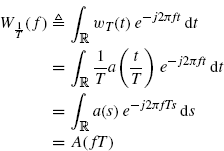3.5 Proofs for Section 2.4.2 “Mean-Square Consistency of the Cyclic Cross-Correlogram”
In this section, proofs of results presented in Section 2.4.2 on the mean-square consistency of the cyclic cross-correlogram are reported.
Lemma 3.5.1 Let a(t) be such that Assumption 2.4.5 is satisfied. We have the following.
(3.60) ![]()
Proof: Since ![]() , item (a) is a consequence of the properties of the Fourier transforms (Champeney 1990). In Assumption 2.4.5 it is also assumed that there exists γ > 0 such that
, item (a) is a consequence of the properties of the Fourier transforms (Champeney 1990). In Assumption 2.4.5 it is also assumed that there exists γ > 0 such that
In reference to item (b), observe that from (2.125) we have
where, in the third equality, the variable change s = t/T is made. Thus, for f = 0,
(see (2.126)). For f ≠ 0, since , we have ...
Get Generalizations of Cyclostationary Signal Processing: Spectral Analysis and Applications now with the O’Reilly learning platform.
O’Reilly members experience books, live events, courses curated by job role, and more from O’Reilly and nearly 200 top publishers.


